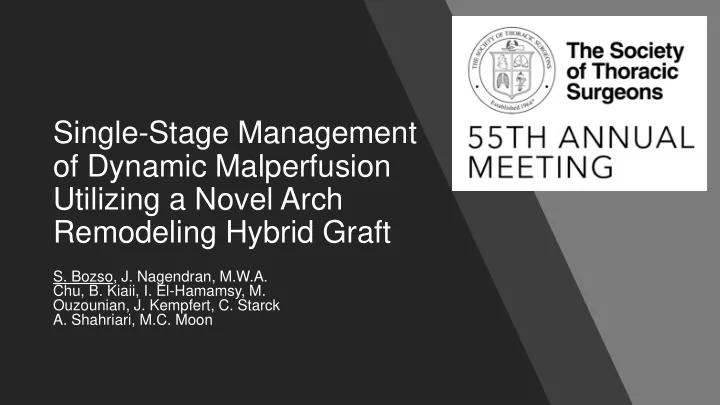

Single-Stage Management of Dynamic Malperfusion Utilizing a Novel Arch Remodeling Hybrid Graft S. Bozso, J. Nagendran, M.W.A. Chu, B. Kiaii, I. El-Hamamsy, M. Ouzounian, J. Kempfert, C. Starck A. Shahriari, M.C. Moon
Background • Acute DeBakey I aortic dissection is a life threatening condition that requires emergent surgery to save the patient’s life • Emergent hemiarch repair is the standard-of-care and it successfully addresses the primary entry tear by resection, however, with several limitations: • Residual false lumen (FL) remains in the distal aorta • Threat of visceral and peripheral malperfusion • Creation of an anastomotic entry tear, allowing for antegrade pulsatile flow and pressurization of FL
Surgically created Anastomotic Negative Entry Tear Remodeling Anastomotic Entry Tear causing Antegrade Pulsatile Flow (APF) * Malperfusion
AMDS Mode of Action Arch & arch vessel Close anastomotic entry tear remodeling and healing Expand and Malperfusion mgmt. stabilize TL and distal remodeling
Objective • To investigate outcomes in patients presenting with acute DeBakey I aortic dissection complicated by malperfusion treated with surgical repair and implantation of the AMDS
Enrollment • Inclusion Criteria • Patients 18-80 years • Acute DeBakey I aortic dissection within 14-days • Exclusion Criteria • Extreme hemodynamic compromise requiring CPR • Marfan, Loeys-Dietz, or Ehlers-Danlos syndrome • Proximal descending thoracic aortic aneurysm >45mm
End-Points and Definitions • CT scans were performed at 1, 3, 6 and 12-months post-operatively • Primary End-Point • Status of malperfusion after AMDS implantation • Malperfusion • Loss of blood supply to a vital organ caused by branch arterial obstruction secondary to the dissection • Supra-aortic vessel malperfusion: high-grade stenosis (>75%) or occlusion of the vessel due to compression by the non-perfused FL leading to interruption of flow
Demographics • From March 2017 to January 2019, a total of 47 patients underwent emergent surgical repair with AMDS implantation • Malperfusion was detected pre-operatively in 55.3% (n=26/47) • The following outcomes focus specifically on the cohort of patients presenting with malperfusion Age (y) 63.5 (55.3, 71.0) Male Gender 65.4% (n=17) Reoperation 3.8% (n=1) Hypertension 53.8% (n=14) Prior Stroke 26.9% (n=7) COPD 11.5% (n=3) Chronic Renal Failure 15.4% (n=4)
Procedure and Hospital Course Successful Device Deployment 100% (n=26) Axillary Artery Arterial Cannulation 92.3% (n=24) Femoral Artery Arterial Cannulation 7.7% (n=2) Median DHCA Duration (min) 34.0 (26.5, 42.5) Median Cerebral Perfusion Duration (min) 32.0 (21.5, 40.5) Median AMDS Implantation Time (min) 3.0 (2.0, 5.5) Median ICU length-of-stay (days) 9.0 (5.8, 13.3) Median hospital length-of-stay (days) 14.0 (9.0, 19.5)
Mortality and Serious Adverse Events 30-day mortality 7.7% (n=2) New neurologic deficit identified post-operatively 7.7% (n=2) Aortic injury associated with device implantation 0% (n=0) New aortic arch branch vessel compromise 0% (n=0) Acute renal failure 19.2% (n=5) Dialysis 19.2% (n=5)
Malperfusion Management • In the 24 patients included in efficacy analysis, 66 vessel malperfusions identified • Two patients were excluded from efficacy analysis due to early death, without a post-operative CT • Hypoxic encephalopathy secondary to bilateral common carotid artery occlusions pre-operatively • Multi-system organ failure
Malperfusion Patient Coronar Innom RCCA LCCA LSCA RSCA Spinal Celiac SMA R Renal L Renal LLE RLE Total y cord art 1 90% 1 2 Occ 1 3 80% 90% 2 4 Occ Occ Occ Occ Occ 5 5 70% 90% 2 6 Occ 90% Occ 3 7 90% Occ Occ 3 8 Occ Occ Occ 3 9 99% x Occ Occ Occ Occ 6 10 x Occ 2 11 Occ Occ Occ Occ 4 12 x 90% 2 13 Occ 90% 90% 3 14 Occ 99% 2 15 Occ Occ 2 16 Occ 99% 2 17 Occ Occ 2 18 Occ Occ 2 19 90% 1 20 Occ Occ 2 21 Occ Occ 2 22 STE Occ Occ Occ Occ Occ Occ Occ 8 23 Occ Occ 2 24 Occ Occ Occ Occ 4 Total 1 6 6 7 2 1 3 6 8 6 10 7 3 66 % of Tot 1.5% 9.1% 9.1% 10.6% 3.0% 1.5% 4.5% 9.1% 12.1% 9.1% 15.2% 10.6% 4.5% 100%
Malperfusion Management • 95.5% (n=63) of vessel malperfusions resolved after AMDS implantation, without a secondary procedure • Supra-aortic: 95.5% (n=21/22) • Visceral: 92.9% (n=13/14) • Renal: 93.8% (n=15/16) • Lower Extremity: 100% (n=10/10) • Paralysis: 100% (n=3/3)
Cerebral Malperfusion • Of the 66 vessel malperfusions, 22 (33.3%) involved supra-aortic vessels • Of the 26 patients presenting with ATAAD complicated by malperfusion, 6 (23.1%) were diagnosed with a neurologic injury post-operatively • Four patients had clinical evidence of cerebral malperfusion in the emergency department pre-operatively • Two patients had a new neurologic deficit identified post-operatively without neurologic symptoms pre-operatively • All post-operatively identified neurologic deficits occurred with dissection or malperfusion of a cerebral vessel • None occurred in patients with anatomically normal cerebral vessels.
Courtesy University of Alberta
D E Nearly Occluded Patent Common Carotid Common Arteries Carotid Arteries G F Occluded Patent SMA SMA Patent Renal Occluded Renal Arteries Arteries Bilaterally Courtesy Bilaterally Montreal Heart Institute
• LCC and L CFA malperfusion Courtesy University Hospital Network, Toronto
Courtesy University Hospital Network, Toronto
Secondary Procedures • Three patients required disease-related secondary procedures • Left renal artery stenting for static malperfusion • Superior mesenteric artery stenting for static malperfusion • Bilateral femoral artery patch angioplasty and left lower extremity fasciotomy secondary to delayed presentation
Key Points • The AMDS is a safe and reproducible adjunct to the current standard-of- care repair in ATAAD without adding significant time or complexity • When faced with malperfusion, the AMDS is capable of effectively treating malperfusion in over 95% of cases • Static malperfusions can be addressed effectively after life-saving surgery on a semi-elective basis • A unique characteristic in this cohort was healing of malperfusions involving cerebral vessels and reversal of dissection-induced paralysis • Based on the data presented we advocate for single-stage management of malperfusion during the index operation without delaying life-saving surgery
Questions?
Recommend
More recommend